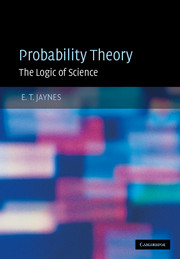Book contents
- Frontmatter
- Contents
- Editor's foreword
- Preface
- Part I Principles and elementary applications
- Part II Advanced applications
- 11 Discrete prior probabilities: the entropy principle
- 12 Ignorance priors and transformation groups
- 13 Decision theory, historical background
- 14 Simple applications of decision theory
- 15 Paradoxes of probability theory
- 16 Orthodox methods: historical background
- 17 Principles and pathology of orthodox statistics
- 18 The Ap distribution and rule of succession
- 19 Physical measurements
- 20 Model comparison
- 21 Outliers and robustness
- 22 Introduction to communication theory
- Appendix A Other approaches to probability theory
- Appendix B Mathematical formalities and style
- Appendix C Convolutions and cumulants
- References
- Bibliography
- Author index
- Subject index
21 - Outliers and robustness
from Part II - Advanced applications
Published online by Cambridge University Press: 05 September 2012
- Frontmatter
- Contents
- Editor's foreword
- Preface
- Part I Principles and elementary applications
- Part II Advanced applications
- 11 Discrete prior probabilities: the entropy principle
- 12 Ignorance priors and transformation groups
- 13 Decision theory, historical background
- 14 Simple applications of decision theory
- 15 Paradoxes of probability theory
- 16 Orthodox methods: historical background
- 17 Principles and pathology of orthodox statistics
- 18 The Ap distribution and rule of succession
- 19 Physical measurements
- 20 Model comparison
- 21 Outliers and robustness
- 22 Introduction to communication theory
- Appendix A Other approaches to probability theory
- Appendix B Mathematical formalities and style
- Appendix C Convolutions and cumulants
- References
- Bibliography
- Author index
- Subject index
Summary
Probably everybody who has been involved in quantitative measurements has found himself in the following situation. You are trying to measure some quantity θ (which might be, for example, the right ascension of Sirius, the mass of a π-meson, the velocity of seismic waves at a depth of 100 km, the melting point of a new organic compound, the elasticity of consumer demand for apples, etc.). But the apparatus or the data taking procedure is always imperfect and so, having made n independent measurements of θ, you have n different results (x1, …, xn). How are you to report what you now know about θ? More specifically, what ‘best’ estimate should you announce, and what accuracy are you entitled to claim?
If these n data values were closely clustered together making a reasonably smooth, single-peaked histogram, you would accept the solutions given in the previous chapters, and might feel that the problem of drawing conclusions from good data is not very difficult, even without any probability theory. But your data are not nicely clustered: one value, xj, lies far away from the nice cluster made by the other (n − 1) values. How are you to deal with this outlier? What effect does it have on the conclusions that you entitled to draw about θ?
We have seen in Chapters 4 and 5 how the appearance of astonishing, unexpected data may cause the resurrection of dead hypotheses; it appears that something like that may be at work here.
- Type
- Chapter
- Information
- Probability TheoryThe Logic of Science, pp. 615 - 626Publisher: Cambridge University PressPrint publication year: 2003



